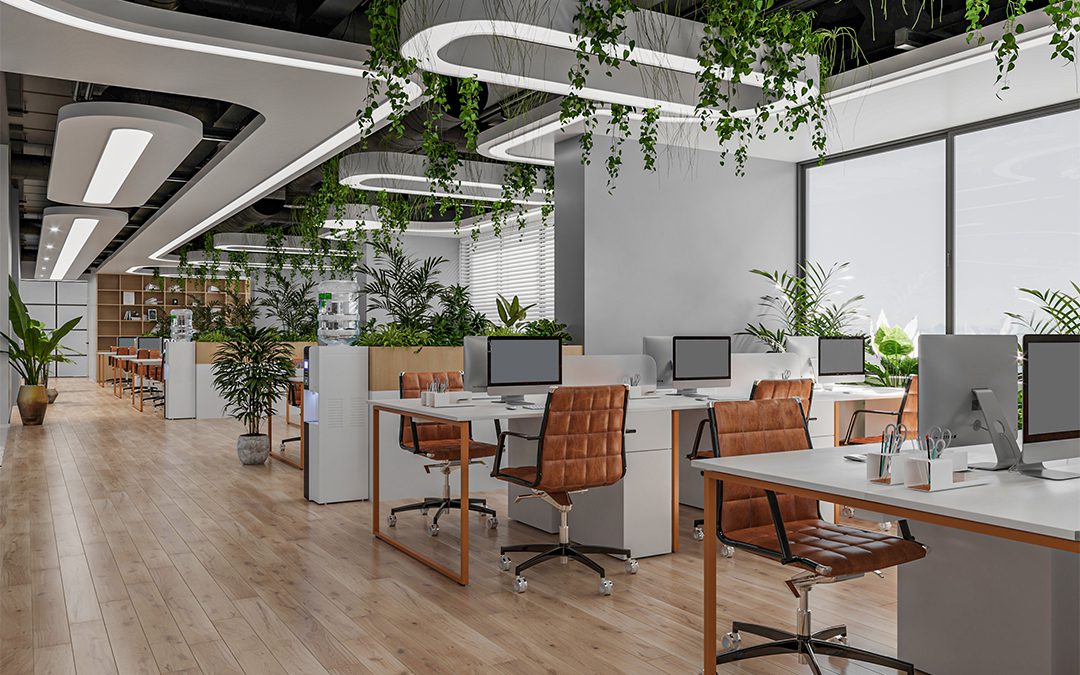Future-Ready Workspaces: 5 Trends in Office Design for a Hybrid World
Designing and remodeling commercial office spaces looks much different today than it did only a decade ago…
Prior to 2020, remote and hybrid work were not common, so office design seldom accounted for remote or hybrid employees. In the years since, however, where people work has changed dramatically: as of February 2025, Gallup reported that 52% of U.S. jobs were hybrid, 27% were fully remote, and only 21% were fully on-site.
Subsequently, the design of commercial office spaces is also evolving. Now, office design trends prioritize flexibility, productivity, and technological integration to better serve today’s hybrid and remote workforce, while also remaining adaptable to the needs of tomorrow.
Here’s a look at some current trends in hybrid-friendly office design, and how commercial architecture and interior design are evolving to meet flexible workspace needs…
Trend #1 – Flexible Layouts
One way modern office design has changed is by becoming more adaptable. A hybrid-friendly space will support a rotating group of on-site employees while also meeting individual needs throughout the workday. As a result, this translates to flexible layouts that enhance collaboration and productivity, so employees can make the most of an in-person work day. Plus, it helps make the transition between solo work and collaborative gatherings easier.
Flexible office layouts might include:
- Modular furniture
- Movable dividers, walls, and/or acoustic screens
- Pods for quiet work
- Booths for one-on-one or small group meetings
- Gathering spaces with plenty of seating options
Trend #2 – Technology Integration
A hybrid-friendly and future-ready office design involves strategic integration of technology — not simply as an “add-on,” but as a crucial consideration from the start. Each space should include smart features that help bridge the gap between in-person and remote employees. Modern meeting spaces, for instance, need to be equipped with tech that allows remote employees to effectively engage with their in-office colleagues.
Trend #3 – Wellness-Forward Design
With more and more people enjoying home as their “other” office, conventional interior designs have also evolved to be more welcoming, pleasing, and supportive of employees’ well-being. People tend to be more productive (and the workplace culture more positive) when they can do their work in enjoyable, mutually-beneficial spaces.
A few design features that can help promote employee wellness include:
- Natural light
- Biophilic elements (features that connect humans and nature)
- Designated collaborative and/or quiet zones
Here’s one example of how today’s workplaces don’t have to look like “traditional” offices.
Trend #4 – Brand-Aligned Interiors
Here’s a modern trend that can make an office space more future-ready: using on-brand design to reflect company culture. That’s because, when employees believe in the company’s values or embrace its culture, and it’s reflected well in the office environment, employee morale and retention can improve!
Depending on the organization, designing for brand alignment could influence aesthetics (i.e., using a logo, color palette, and styling cohesively with other branding). Or, it could affect bigger-picture design issues like floor plan, flow of business, and material choices (i.e., choosing renewable building materials to reflect a company value of sustainability).
Trend #5 – Amenities That Matter
In this hybrid era, sometimes developing positive, trusting relationships among team members can be a challenge. After all, it can be more difficult to get to know colleagues and form authentic connections if in-person interactions are rare. That’s why this trend is important: strategic design of office amenities can help maximize opportunities for meaningful interactions when employees do work from the office.
This might mean creating centrally-located spaces for people to gravitate to during breaks, such as lounges, outdoor areas, or coffee bars. Within those spaces, the level of configuration and comfort may also encourage employees to stay, connect, and collaborate — hopefully contributing to a stronger, more collaborative team culture!
Designing for the Hybrid Era
If you’re designing a new office (or if it’s time for a redesign), our team at George Armour Ewart, Architect can help you create a modern, commercial workspace that balances design, flexibility, and long-term function. By combining timeless fundamentals of architecture and design with relevant trends and best practices, Team Ewart is here to ensure every commercial space is future-ready and hybrid-friendly.
Interested in learning more? Check out examples of our work here, or you can contact us online or by email at info@georgeewart.com.

